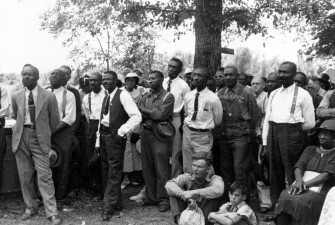The Southern Tenant Farmers Union (STFU) was founded in Tyronza, Arkansas in July 1934 by black and white tenant farmers and Socialist Party members. The STFU is part of a rich tradition of labor organizing in the Depression-era South amongst mostly Black agricultural laborers.
Since the Reconstruction era the vast majority of Southern farmers were exploited under semi-feudal labor conditions, paying for their land usage with crops, and easily subject to the whims of the white landowners. Their plight was exacerbated by the Great Depression and ironically by a highly touted New Deal reform, the Agricultural Administration Act (AAA). As provisions of the AAA reduced large farmers’ need for laborers, the lives of 1930s sharecroppers and tenant farmers grew more difficult. That they built successful unions, often with help from radical organizations, is one of the most inspiring chapters of African American and labor history.
Originally, the STFU was formed to protest the eviction of twenty-three farming families on a plantation near Tyronza, but grew in scope to fight generally for the rights of sharecroppers, tenant farmers, and farm laborers. By 1936, the union had spread to Texas, Missouri, Tennessee, Oklahoma, and Missouri, and at its height in 1938, claimed over 30,000 members in over 300 separate locals. The newspaper, the Sharecroppers’ Voice, described the struggle of the Union and the workers they represented. Throughout its history, the STFU was remarkable among tenant farmers and sharecroppers’ unions in the South for its commitment in theory and in practice to building what was rare for the time and region, a racially integrated union.
The STFU faced enormous legal and extralegal violence and repression precisely because of its interracial nature and its attack on the longstanding exploitative agricultural system of the South. Union members and organizers were often harassed by planters who invaded union meetings. They also faced local police who arrested them on various charges or from terror groups who assaulted them and repeatedly threatened lynching and other forms of violence. This situation made the STFU far more dependent than Northern industrial unions on outside funding and occasional safe refuge for its organizers.
Nonetheless, the Southern Tenant Farmers Union briefly thrived. Rallies and meetings, heavily influenced by the Baptist church to which most black and white cropper and farming families belonged, were revivalist affairs, complete with union songs, skits, and addresses. Because of the church influence, many women became deeply involved in the union’s activities.
The Southern Tenant Farmers Union also had a troubled relationship with the recently formed national union federation, the Congress of Industrial Organizations (CIO). Like the STFU it embraced a more inclusive, anti-racist alternative to the American Federation of Labor. Many in the urban, industrial union dominated CIO never understood or accepted a labor organization comprised of agricultural workers. The STFU joined the CIO in 1937 but withdrew a year later. The Southern Farmers Tenant Union declined by the early 1940s as national attention focused on the coming world war, radicals were driven out of union leadership positions, and New Deal programs which encouraged the mechanization of farming reduced the need for sharecropping and tenant farming.
The legacy of the Southern Tenant Farmers Union, though, as an integrated, vibrant union movement, stands as an example of Black and white labor militancy, and its emphasis on the power of revivalist songs and speeches in social struggle presaged the early civil rights movement.

